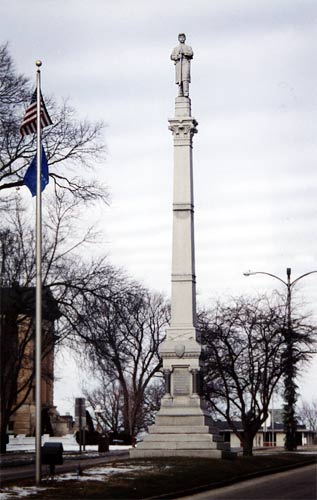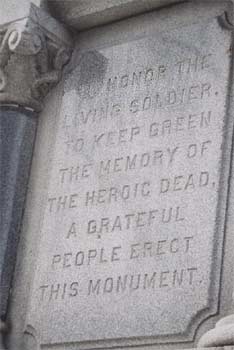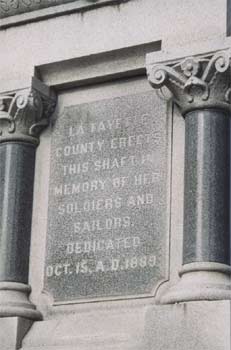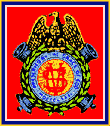The Lafayette County Soldiers & Sailors Monument at Darlington, Wis.

Erected in 1889, this monument to the Soldiers and Sailors of the Civil War stands in Darlington, LaFayette County. Two inscriptions on the base read:
To Honor the Living Soldier.
To Keep Green the Memory of the Heroic Dead.
A Grateful People Erect this Monument.
and
LaFayette
County erects
this shaft in
memory of her
soldiers and
sailors.
Dedicated
Oct. 15 A.D. 1889.
On November 11, 1885, the Lafayette County Monumental Association was organized with Articles of Corporation filed with the Register of Deeds. Capitol stock of the Association was fixed at $6,000 and divided into 6,000 shares of $1.00 each. Any person buying even one share could become a member of the corporation, which was to be perpetual.
Officers elected were:
H.S. Magoon, president; Col. C.W. Stevenson, vice president; Lars E. Johnson, secretary; and Joseph Blackstone, treasurer. 16 Directors were to make up the board, the terms to be served in a rotating manner.
Association president Magoon petitioned the County Board to levy a $2,000 tax, with the promise that if it did, he would personally contribute $1,000 to the cause. He felt his offer was safe as taxpayers rarely vote to raise their taxes. The question was put in the form of a referendum during the next election and carried throughout the county by an overwhelming majority…much to the surprise of many, including Magoon.
There was a lively debate in January 1886, as to what kind of memorial to build. Some felt that a memorial hall, to house meetings records and war mementos would be useful.
Others felt that they had voted for the erection of a monument not a hall, and others had second thoughts about the location, stating that it should benefit the entire county and not just the City of Darlington.
In January 1887, the county paid its $2,000 to the Association and Mr. Magoon turned over $1,000, stating that he intended to canvas the county for the remainder of the needed funds. However, when Magoon turned over his check to the Association, he had made certain conditions that, if not met, would result in the refund of his check. One of these was that the monument had to be completed by January 1, 1889. When it was not, he tried to get his money back. The Supreme Court ruled in favor of the Association.
After the court case was settled, fund-raising was again underway. Harvey GAR Post was the first to respond with $100.
When Capt. S.W. Osburn resigned as president of the association in April, Col. Stevenson filled the vacancy and a special committee was appointed to solicit funds. It was hoped that the monument would be ready for a July 4th unveiling.
 On May 10, 1889, bids from seven granite firms were opened. The contract was let to the South Ryegate Works of Vermont with a bid of $6,000. The contract stipulated that the monument was to be completed by October 15, 1889. The stones did arrive and everything was ready in time for the big day.
On May 10, 1889, bids from seven granite firms were opened. The contract was let to the South Ryegate Works of Vermont with a bid of $6,000. The contract stipulated that the monument was to be completed by October 15, 1889. The stones did arrive and everything was ready in time for the big day.
The shaft of the monument is 12 feet square at the base and 56 feet high. Made of Vermont granite, it is topped by the statue of a Union soldier at parade rest. Inscriptions on the sides read as follows: On the south-"Lafayette County erects this shaft in memory of her soldiers and sailors;" facing north-"It shall speak to the young of the honor and dignity of citizenship, of the priceless cost of the country and Union;" on the east-"To honor the living soldier, to keep green the memory of the heroic dead, a grateful people erect this monument;" facing west-"They died, the Nation lives."
The big day finally arrived. Although the cloudy skies threatened, the rain held off and did not dampen the festivities. Between 6,000 and 10,000 people witnessed the grand celebration. By daybreak, people from rural areas began filling the streets. Every building, from city limit to city limit, was decorated with flags and bunting. Paintings of prominent Civil War generals were suspended across the streets along the line of march. The day officially began with a salute of seven guns, which "awakened the slumber of multitudes within a radius of 10 miles."
Trainloads of celebrants began to arrive. The delegation from Mineral Point brought their famous cornet band. The Monroe GAR Post was led by their drum corps. All the visiting posts were greeted enthusiastically by cheers from the crowd.
Governor Hoard and his staff, as well as the Lt. Governor, State Treasurer, Attorney General and the State Insurance Commissioner came from Madison. The main speaker of the day was Col. George W. Bird, also from Madison.
The one o'clock parade was a grand procession, made up of the parade marshal and aides, Wisconsin State Militia, President of the Day, orators, state officers and invited guests, all in carriages; officers of the Monumental Association; drum corps, GAR posts and veterans, all civic societies and fire companies; and citizens. Line of march was up Main to Louisa Street, east to Ohio, north to Bird's corner, west one block, south two blocks, west to Main and to the grounds.
 A chorus of 150 trained voices, directed by Gen. James Blintiff, sang patriotic songs and Rev. A. Hurd offered a prayer.
A chorus of 150 trained voices, directed by Gen. James Blintiff, sang patriotic songs and Rev. A. Hurd offered a prayer.
P.A. Orton delivered a welcoming speech and introduced Gov. Hoard, who responded with appropriate remarks, congratulating the citizens of the county for their fine achievement.
Col. G.W. Stevenson then spoke, at the conclusion of which, Miss Bessie McEwen, representing the Goddess of Liberty, unveiled the monument. There was a grand salute and great applause. R.H. Williams, Commander of Harvey GAR Post, dedicated the monument, after which H.C. Martin read letters of regret from Gen. Sherman and other distinguished men. After more vocal music, Col. Bird delivered the main address. Concluding the ceremony, Miss Florence Swearington recited an original poem, written by Miss Maria Agur.
In the evening, a huge fireworks display took place, accompanied by music from bands, drum corps and the Salvation Army.
According to graffiti on a wall of the ballroom in the Van Osdell Hotel (Thompson House, 145 W. River St.), there was a dance that evening. The note states that the weather was mild, but cloudy. The writers hoped it didn't rain as "we want to walk the girls home." It was signed by three young men.
Interestingly, H.S. Magoon died of apoplexy on March 3, 1889, failing to get his money back, and in seeing both the completed monument and the spectacle of its unveiling.
In 2000, lighting was installed to illuminate the monument at night, at a cost of $1200.
From an article by Marion Howard in the Darlington Republican Journal, February 10, 2000, using information from the Darlington Republican and Democrat newspapers, dating from Novemeber 1885 to October 1889.
Department of Wisconsin

Comments to Dept. Signals Officer
Last Updated: